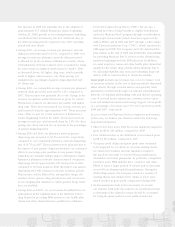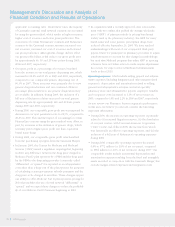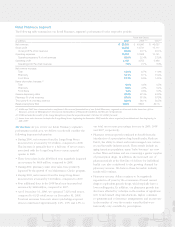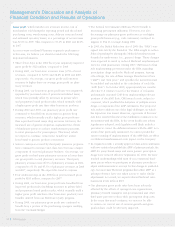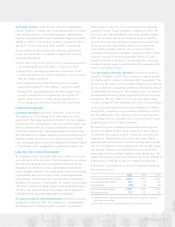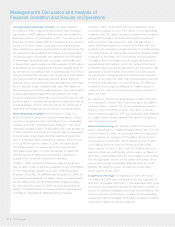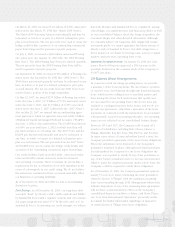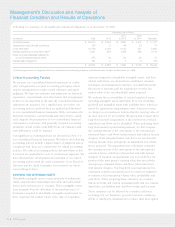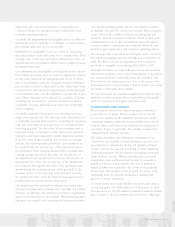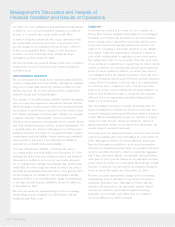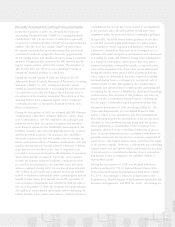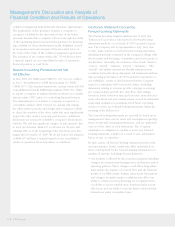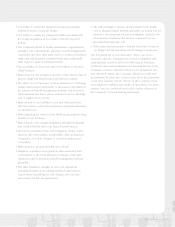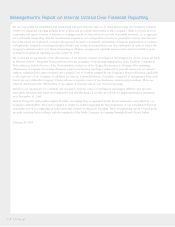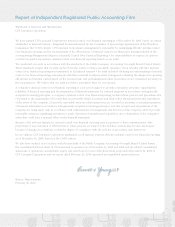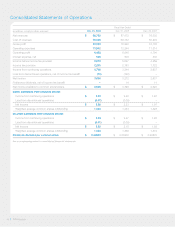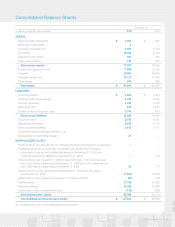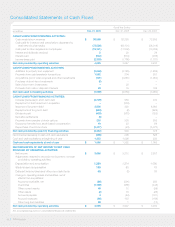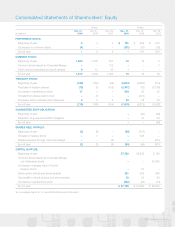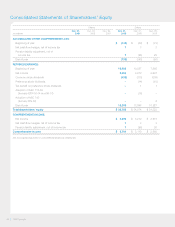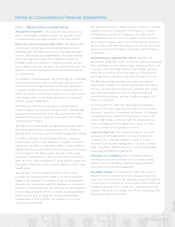CVS 2009 Annual Report Download - page 43
Download and view the complete annual report
Please find page 43 of the 2009 CVS annual report below. You can navigate through the pages in the report by either clicking on the pages listed below, or by using the keyword search tool below to find specific information within the annual report.
combinations that would have been treated as an adjustment
to the purchase price allocation if they would have been
recognized under the previous business combination guidance.
In April 2009, the FASB issued further guidance as it relates
to ASC 805 (formerly FASB Staff Position No. FAS 141(R)-1,
“Accounting for Assets Acquired and Liabilities Assumed in
a Business Combination That Arise from Contingencies”) to
addresses the initial recognition, measurement and subsequent
accounting for assets and liabilities arising from contingencies
in a business combination, and requires that such assets
acquired or liabilities assumed be initially recognized at fair
value at the acquisition date if fair value can be determined
during the measurement period. If the acquisition-date fair
value cannot be determined, the asset acquired or liability
assumed arising from a contingency is recognized only if
certain criteria are met. This guidance also requires that a
systematic and rational basis for subsequently measuring and
accounting for the assets or liabilities be developed depending
on their nature. The adoption of this guidance may have an
impact on the accounting for future business combinations,
but the impact is dependant upon acquisitions at that time.
During the first quarter of 2009, we adopted SFAS No. 160,
“Noncontrolling Interests in Consolidated Financial State-
ments”), which is now included in ASC 810 Consolidations.
This statement requires the presentation of net income (loss)
allocable to noncontrolling interests along with net income
(loss) attributable to shareholders of the Company to be
separately disclosed in the consolidated statement of opera-
tions. Noncontrolling interests in consolidated subsidiaries are
generally required to be reported as a separate component of
equity in the consolidated balance sheet, apart from the equity
of the parent company. However, a redeemable noncontrolling
interest subject to a put option, which may require the purchase
of an interest in a consolidated subsidiary from a noncontrol-
ling interest holder, is required to be classified outside of
shareholders’ equity.
During the first quarter of 2008, we adopted additional
guidance within ASC 715-60 Defined Benefit Plans-Other
Postretirement (formerly Emerging Issues Task Force (“EITF”)
No. 06-4, “Accounting for Deferred Compensation and
Postretirement Benefit Aspects of Endorsement Split-Dollar Life
Insurance Arrangements” and EITF No. 06-10, “Accounting for
Recently Adopted Accounting Pronouncements
In the third quarter of 2009, we adopted the Financial
Accounting Standards Board (“FASB”) Accounting Standards
Codification (“ASC”) as the source of authoritative generally
accepted accounting principles (“GAAP”) for nongovernmental
entities. The ASC does not change GAAP but rather takes
the numerous individual pronouncements that previously
constituted GAAP and reorganizes them into approximately
90 accounting topics, and displays all topics using a consistent
structure. Citing particular content in the ASC involves specify-
ing the unique numeric path to the content. The adoption of
ASC did not have any effect on our consolidated results of
operations, financial position or cash flows.
During the second quarter of 2009, we adopted ASC 855
Subsequent Events (formerly Statement of Financial Accounting
Standards (“SFAS”) No. 165, “Subsequent Events”) which
establishes general standards of accounting for and disclosure
of events that occur after the balance sheet date but prior to
the issuance of the financial statements. The adoption of this
standard did not have a material impact on the Company’s
consolidated results of operations, financial position, cash
flows or disclosures.
During the first quarter of 2009, we adopted ASC 805 Business
Combinations (“ASC 805”) (formerly SFAS No. 141(R), “Busi-
ness Combinations”). ASC 805 establishes the principles and
requirements for how an acquirer recognizes and measures
in its financial statements the identifiable assets acquired, the
liabilities assumed, any noncontrolling interest in the acquiree
and the goodwill acquired. The guidance also establishes
disclosure requirements that will enable users to evaluate the
nature and financial effects of business combinations. ASC 805
requires that income tax benefits related to business combina-
tions that are not recorded at the date of acquisition are
recorded as an income tax benefit in the statement of operations
when subsequently recognized. Previously, unrecognized
income tax benefits related to business combinations were
recorded as an adjustment to the purchase price allocation
when recognized. During 2009, we recognized approximately
$147 million of previously unrecognized income tax benefits
related to business combinations (after considering the federal
benefit of state taxes), plus interest, due to the expiration of
various statutes of limitations and settlements with tax authori-
ties. As of December 31, 2009, the Company had approximately
$20 million of unrecognized tax benefits (after considering the
federal benefit of state taxes), plus interest, related to business
2009 Annual Report 39


